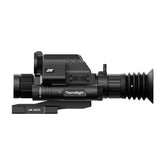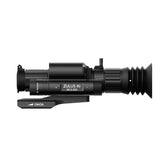Beginner’s Guide to Thermal Scopes: Everything You Need to Know Before You Buy
Thermal vs. Night Vision: Why Thermal is a “Cheat Code”
Are you looking to enhance your ability to hunt at night? Well, thermal scopes give you an edge that is borderline cheating. While night vision is great at seeing at night, it just amplifies available light. Thermal does not need light and allows you to detect potential game a lot easier and faster.
Night vision is great, but there are times when it may not help with hunting. Optical camouflage, like the color of the game you are hunting, can help hide an animal if it blends with the background. Physical camouflage, like vegetation or other landscape, can physically block or obscure the animal from night vision.
Thermal is like a cheat code. It sees heat. It does not rely on traditional light. While night vision needs some light to see, thermal can see in complete darkness. This makes it very effective at seeing potential game no matter the lighting conditions. Since thermal does not rely on light, certain particulates like smoke and dust typically do not affect your ability to see with thermal. If an animal is hiding behind vegetation, its heat can be detected in the gaps between the leaves. It’s much easier seeing small animals like rabbits in tall grass with thermal than it is with night vision.

The 3 Ranges of Thermal: Detection, Recognition, Identification
When considering using a thermal scope, you should understand the distances you are able to “see” with thermal. There are three distances to consider: detection, recognition, and identification. Detection is the farthest you can “detect” a thermal signature. This is usually rather far for most thermal devices in the commercial market. However, this depends on the game you are looking at. A cow shows up pretty easily past 1,000 yards. But a rabbit or squirrel? They will show up a bit closer. However, detection is just the ability to see a blob of heat from a far distance. It can be difficult to judge distances with thermal scopes, especially if you are hunting in an area you are not intimately familiar with the landscape. A blob of heat can be a big blob far away or a small blob close up. Laser rangefinders, especially thermals that have them built-in, are extremely helpful with this.
As you get closer to a heat signature, a thermal scope may start to show a shape that might give you more information. The amorphous blob of heat might start to show legs. Maybe you can start to see a little more. As my more experienced hunting friend educated me: if it has a neck, it can’t be a pig. He was talking about deer. When deer are not grazing, they keep their head upright and erect to use their superb hearing to detect predators. Well, deers have a distinct shape at a certain distance with thermal. But is it a doe or a buck? That is important to know depending on the hunting tag you have. It should be noted that it is usually illegal to hunt deer at night unless you have the proper permits.

So now you need to get closer for positive identification. This is typically a lot closer. Close enough to see fine details. Think of a coyote. At a certain distance, you will be able to make out its shape, but are you sure it is a coyote? Maybe it is a stray dog or possibly a fox? This is why positive identification is very important when hunting at night.
While thermal is a superpower like night vision, it has its drawbacks. In most cases, thermal is low resolution compared to other ways of hunting at night. Thermal sensors cannot see through water or glass. Since they cannot see light, you cannot use any lasers, and you will not be able to see “eye shine”, like when traditional night hunters use lights to shine on game and see the reflection of its eyes.
How to “Read” the Heat: A Hunter’s Guide
Seeing with thermal is all about heat. But specifically, a difference in temperature. Thermal sensors operate better at night because it is cooler at night and game animals are hot blooded. So be aware of the ambient temperature when using thermal. Another consideration is the background your target is standing in front of. If you see an animal up on top of a hill, it will be “backlit” by the cold sky. But if it is standing in front of large rocks that have been baking and absorbing the heat of the sun all day, it might be harder to pick them out. Depending on the landscape you may get false positives. As said earlier, rocks absorb heat, but some vegetation can also retain heat after the sun goes down. This is where experience helps like the “pigs don’t have necks”. Movement and behavior will of course inform you as well. Dogs do not tend to howl up at the sky while coyotes do, so while you might be too far away to positively identify a canine shaped target, if it howls up at the sky, chances are it is not a stray dog.

Choosing a Scope: Resolution, Magnification & Your Hunting Style
There are other factors to consider when choosing a thermal scope. I hinted at resolution being an issue, however, a higher resolution thermal is not necessarily better than a lower resolution thermal. For lack of a better term, optical magnification plays a significant role in your ability to see far. A 1x base magnification 640 resolution thermal is not going to see that far compared to a 384 with a base magnification of 2.5x. While the 640 resolution can certainly detect heat at distance, the lens is the limiting factor. In fact, higher optical magnification can make a lower resolution thermal perform better than higher resolution. There are some military thermal systems that are only 320 resolution, but with high optical magnification, they can recognize people past a mile or more.
When choosing a thermal scope, think of how you hunt normally in the day. You typically scan with your eyeballs first. Looking for shapes, color, and movement. Your eyeballs are the highest resolution you can see with but they lack magnification. So we usually use binoculars to see farther or our day scopes to really see far. The same applies with thermal. There are diminishing returns with low magnification that going higher resolution does not really help that much more.

So should you get a high magnification thermal? Depends on what you are hunting. Most night hunters are hunting pigs within 100 yards. Coyotes tend to be hunted at further distances. So choose the right thermal for the task. High magnification thermal will give you a smaller field of view than a low magnification thermal. You might want to consider getting a low magnification handheld thermal for scanning for potential game. Once you detect something, switch to a weapon-mounted thermal scope with higher magnification.
There are other specs to consider like refresh rate. The higher, the better. However, you can get by with lower refresh rate if you are not moving while shooting. If you pan on a tripod to track a moving target, you will want a higher refresh rate.
Key Features That Make a Difference
Many thermal scopes have a wild variety of features built-in. Color palettes is usually based on personal preference but most hunters tend to prefer black hot or white hot. The “Predator Vision” with the blues and greens is fun to look through though. Chose the palette that works the best in the environment you are in. Try them out, but usually, it is the black and white palettes that tend to show the best images.

As mentioned earlier, the single most helpful feature for a thermal scope is a built-in laser rangefinder. This will help inform you if it is worth pursuing an animal based on how far it is. Our new HYDRA-LRF series have built-in laser rangefinders. As do our ThermNight series of scopes. Another bonus feature for all of our scopes, equipped with laser rangefinders, is the built-in ballistic calculator. When programmed to your gun and ammo and setup in the scope, the scope will show you where to aim for the ballistic drop at the distance you just ranged.
This leads us into choosing your scope for its function over its form. The HYDRA series of scopes is a multi-function scope. It works as a standalone scope, but with a quick detach mount like the QDM150, you can leave the mount on your gun and detach the HYDRA for use as a handheld monocular. The HYDRA can also function as a clip-on for low magnification up to 4x day scope. Here you might want to get the QDS150. It has fewer parts and it is better for zero retention.

But why limit yourself to only seeing heat? Why not have thermal and night vision in one scope? Our ThermNight series combines digital day/night, like our ZULUS scopes, with a thermal sensor. When setup properly, you can see thermal in the picture-in-picture while having digital day/night vision in the main image. No need to switch back and forth. Just glance up and down to see one or the other. The ThermNight scopes have a special feature called Thermal Zoom Lock. This locks your thermal at its base magnification while still allowing you to zoom with the higher resolution digital day/night sensor. Think of it like a thermal red dot on top of a long-range scope. You can scan an area with the wider FOV thermal and once you see something of interest, you point the reticle at it and glance down to your digital day/night image and it will already be looking at your target with higher resolution.

Power, Durability, and Final Advice
How long you hunt at night will also help you drill down on what thermal to get. Take a look at how a thermal scope is powered. They typically run on a lithium ion (li-ion) battery. Most commercial options use a rechargeable li-ion battery but do your research. Some companies force you to use a proprietary shaped battery while others use a more common place 18650 rechargeable battery. No need to buy the same battery from the scope manufacturer when you can just get a replacement off Amazon. Some scopes, like our ThermNight TNC335R and TNC635R use a larger 21700 battery to help power the bigger screens and sensors. If you need longer run time, you can carry spare batteries or plug a USB power bank into the USB-C port in any of our digital scopes.

As with any optical device, you want one that is rugged and will last. Our digital scopes, including the HYDRA thermal scopes, are all IP67 rated for water and dust. We also offer world class customer service and technical support for all of our scopes (Email: info@dntoptics.com, Tel: (713)364-9198). If you have questions or need help setting up your scope, our technical support team are all users of our scopes and have used them extensively with real world experience. Our customer service is also available to help you wade through all the options and differences of our thermal scopes. They have used them in the field and can help you hunter to hunter.







